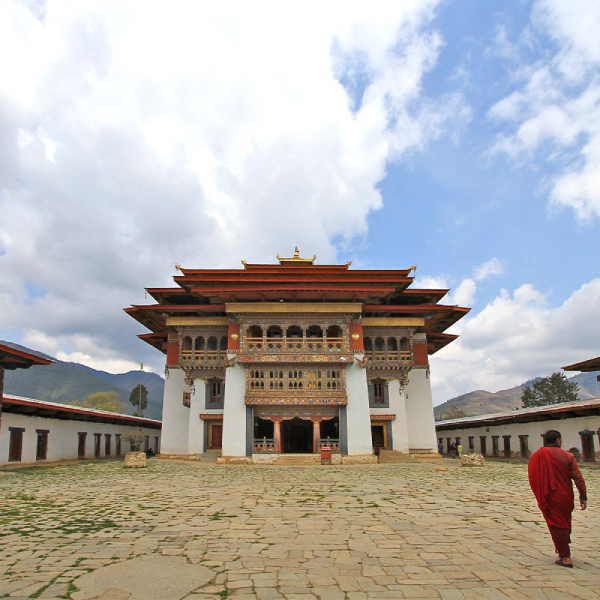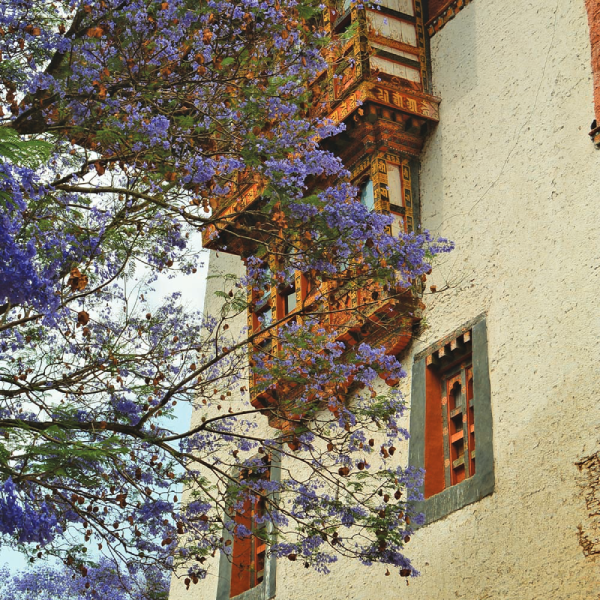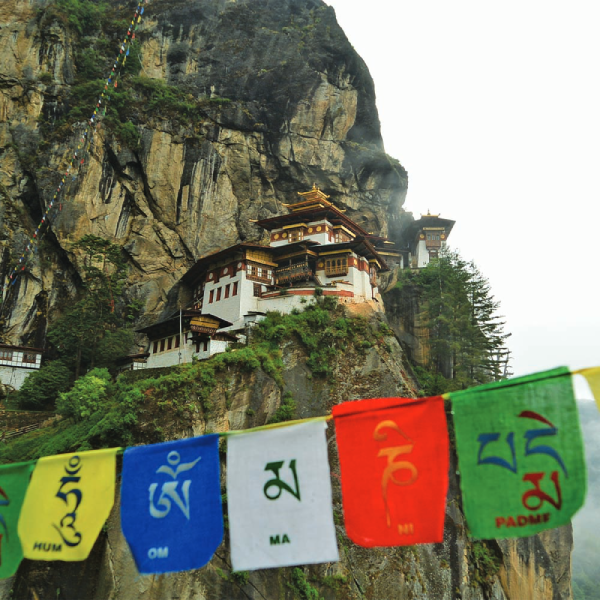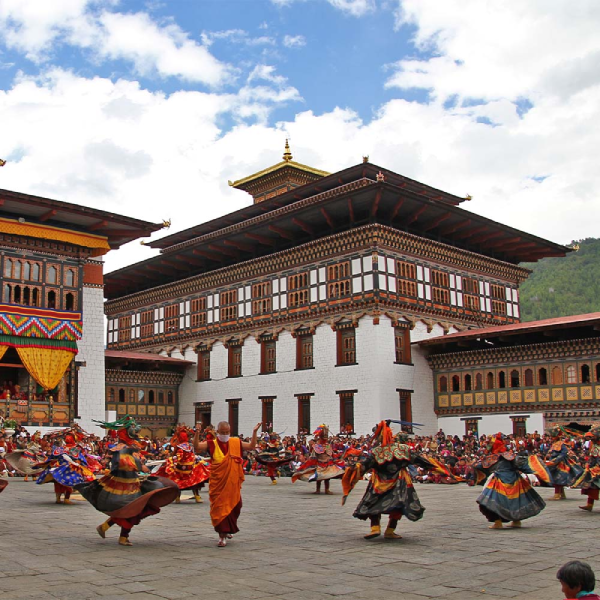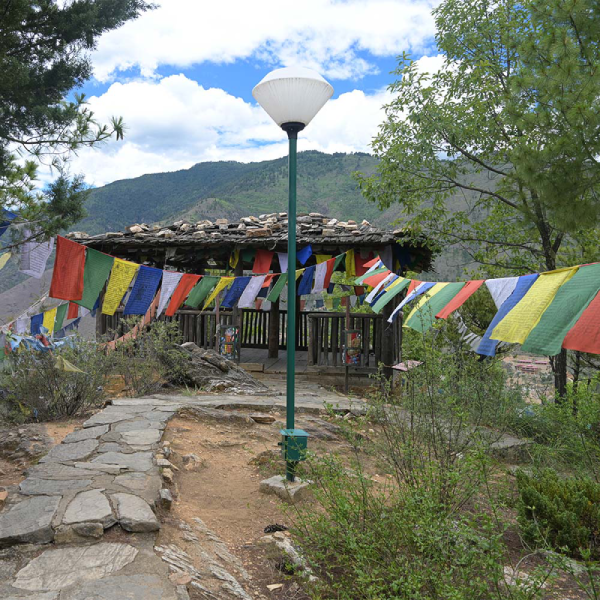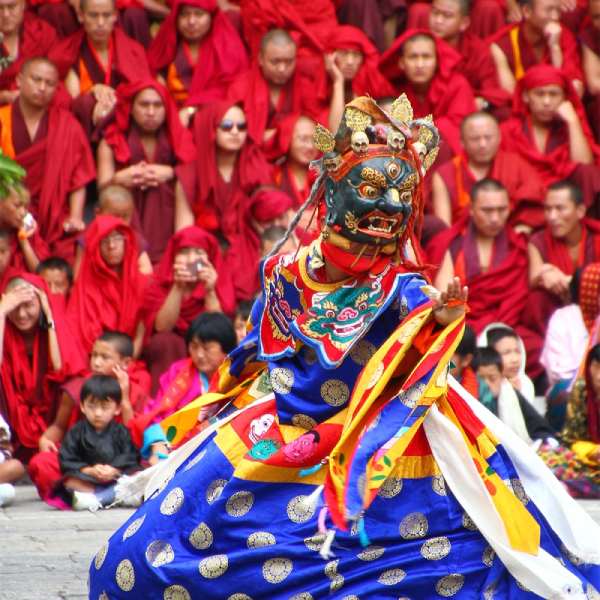Explore the cultural and spiritual highlights of western Bhutan, beginning in the capital city of Thimphu, where tradition and modernity coexist in a uniquely Bhutanese way. Journey through breathtaking landscapes—winding mountain roads, lush valleys, and peaceful villages—while visiting historic dzongs, ancient temples, and vibrant markets that reflect the soul of the kingdom. Along the way, you'll discover sacred sites like the Punakha Dzong and Chimi Lhakhang, each rich in legend and spiritual significance. The journey culminates with an unforgettable hike to the iconic Taktsang Monastery, or Tiger’s Nest, a sacred sanctuary clinging dramatically to a cliffside. This remarkable experience, surrounded by natural beauty and deep devotion, is sure to be the highlight of your exploration through Bhutan’s western heartland.
Discover the Cultural Heart of Western Bhutan
Tours Details
- Home
- Bhutan Tour
- Discover the Cultural Heart of Western Bhutan
Discover the Cultural Heart of Western Bhutan
Short Itinerary
| Title | Accommodation | Meals |
| Day 1: Arrival at Paro | -/L/D | Hotel |
| Day 2: Paro to Thimphu | B/L/D | Hotel |
| Day 3: Thimphu to Punakha | B/L/D | Hotel |
| Day 4: Punakha – Wangduephodrang | B/L/D | Hotel |
| Day 5: Wangduephodrang to Gangtey | B/L/D | Hotel |
| Day 6: Punakha to Paro | B/L/D | Hotel |
| Day 7: Departure | B |
Tour Program
Expand AllAs you board your flight to Paro, prepare for an unforgettable experience. This scenic mountain journey offers spectacular aerial views of the towering peaks of the Himalayas, including some of the world's highest summits. As the aircraft glides over the emerald landscapes of the Bhutanese Himalayas, you’ll witness dramatic ridges, deep valleys, and forested slopes rising steeply from the lowlands — a majestic gateway into Bhutan.
Upon arrival at Paro Airport, step into the crisp mountain air and take in your first glimpses of this mystical kingdom. You'll be welcomed by the serene beauty of the Paro Valley, where you’ll spend your first night. Settle into your accommodation and unwind amid peaceful surroundings, allowing yourself to fully absorb the spirit of Bhutan before your journey continues.
Hotel
-/L/D
Your second day in Bhutan begins with a scenic drive from Paro to Thimphu, the capital city nestled amidst the rolling green hills of a serene valley. After a hearty breakfast, set out on this picturesque journey along winding mountain roads, passing through charming villages, terraced fields, and dense pine forests that offer a glimpse into the country’s tranquil countryside.
Upon reaching Thimphu, dive into the cultural richness of the city, beginning with a visit to the National Library. Home to an invaluable collection of ancient Buddhist scriptures and manuscripts, it offers insight into Bhutan’s deep spiritual and literary traditions.
Continue to the National Folk Heritage Museum, where traditional rural life comes alive through displays of household artifacts, tools, and architecture. This intimate museum provides a window into Bhutanese customs and daily life across generations.
Next, drive up to the BBS Tower, a favorite viewpoint offering panoramic vistas of Thimphu Valley. Pause to admire the stunning landscape and capture photographs of the city framed by lush, forested hills.
In the afternoon,explore the spiritual heartbeat of Thimphu at the Memorial Chorten. Built in honor of the Third King, this revered stupa is a center for prayer and reflection, where you'll witness locals engaged in their daily spiritual rituals.
Your day concludes with a visit to the Trashichhodzong, a majestic fortress-monastery that houses both the seat of government and the central monastic body. Its impressive architecture and peaceful courtyards reflect the harmonious blend of politics and spirituality in Bhutanese life.
After a day of enriching experiences, check in to your hotel in Thimphu and unwind. Spend the evening relaxing in the comfort of your accommodation, surrounded by the quiet allure of the Himalayan capital.
Hotel
B/L/D
On your third day in Bhutan, set off on a scenic journey from Thimphu to the verdant Punakha Valley, a route steeped in natural beauty and cultural significance. After a hearty breakfast at your hotel, begin the drive towards Dochula Pass, nestled at 3,080 meters above sea level. This iconic mountain pass offers one of Bhutan’s most awe-inspiring panoramas — a sweeping 360-degree view of the snow-draped eastern Himalayas, framed by the 108 intricately built memorial chortens that crown the ridge.
Continuing your descent into the warmer Punakha Valley, stop at Chimi Lhakhang, the famous fertility temple dedicated to the eccentric 15th-century saint, Lama Drukpa Kuenley — affectionately known as the Divine Madman. A short walk through rice fields leads you to this unique shrine, believed to bless couples with fertility and bring good fortune.
Upon arriving in Punakha, visit the majestic Punakha Dzong, dramatically situated at the confluence of the Pho Chu (Male River) and Mo Chu (Female River). Often considered one of Bhutan’s most beautiful fortresses, this architectural masterpiece once served as the ancient capital and still plays a vital role in Bhutan’s spiritual and political life.
In the afternoon, make your way to the serene Khamsum Yulley Namgyal Chorten, an exquisite example of traditional Bhutanese artistry and spiritual symbolism. Commissioned by Her Majesty the Queen Mother, this temple took eight years to construct and offers commanding views of the surrounding valley after a gentle hike through rice paddies and forested trails.
As the day draws to a close, check in to your hotel in Punakha and unwind amid the peaceful rhythms of the valley. Rest well and prepare for more adventures ahead.
Hotel
B/L/D
Begin your fourth day in Bhutan with a hearty breakfast at your hotel in Punakha before setting out on a scenic drive to Wangdue Phodrang. As you travel, take in the stunning vistas of Bhutan’s lush countryside — rolling hills, terraced fields, and vibrant villages that showcase the region’s natural charm.
Upon arrival in Wangdue Phodrang, visit the impressive Wangdue Dzong, an architectural marvel steeped in history and cultural importance. This fortress has long stood as a symbol of Bhutanese resilience and spirituality, offering fascinating insights into the country’s heritage.
In the evening, enjoy a leisurely stroll through Bajo Town, the vibrant heart of Wangdue Phodrang. Browse local shops and markets, where you can find an array of authentic Bhutanese crafts and goods, reflecting the artistry and traditions of the area.
Later, continue your drive to Gangtey, a tranquil valley renowned for its natural beauty and unique cultural heritage. Check in to your accommodation here, where you’ll spend a peaceful night surrounded by serene landscapes.
Hotel
B/L/D
Your fifth day in Bhutan offers an immersive journey through some of the kingdom’s most pristine and captivating landscapes.
After a nourishing breakfast, leave Gangtey and enjoy a scenic drive to the renowned Phobjikha Valley. En route, as you pass through Wangdue Phodrang, take a moment to appreciate the sweeping views and the tranquil countryside that unfolds around you.
Upon arrival in Phobjikha Valley, delve into this enchanting glacial valley, renowned not only for its stunning natural beauty but also as the winter sanctuary of the rare and elegant black-necked cranes. Spend time exploring the peaceful surroundings, soaking in the serene atmosphere and the rich biodiversity of this protected habitat.
Following a delightful lunch, begin your return journey to Punakha. Your drive will wind through lush forests teeming with oak and rhododendron trees, offering a sensory immersion in Bhutan’s vibrant natural environment.
Arrive in Punakha and check in to your hotel, where you can relax and reflect on the day’s extraordinary experiences amidst the peaceful valley setting.
Hotel
B/L/D
As dawn breaks over Punakha, you’ll set off on a journey back to Paro — a gentle return through Bhutan’s living canvas of misty ridges, whispering forests, and quiet hamlets tucked beneath rolling hills. The drive itself is a reminder of Bhutan’s rhythm: unhurried, peaceful, and deeply connected to the land.
Once in Paro, begin your day with a comforting breakfast—perhaps fresh ema datshi and butter tea—to ground yourself for what lies ahead.
Your first step into Paro’s past begins at Ta Dzong. Once a guardian tower, it now watches over Bhutan’s story in silence. Inside, you'll wander through rooms filled with ancient scrolls, warrior armor, sacred relics, and artistic expressions of a kingdom that has held on to its essence for centuries.
From there, a short walk leads you to Rinpung Dzong, a fortress of stone and soul. With its layered courtyards and red-roofed towers, this structure isn’t just a building—it’s a living place of worship and governance, where monks chant in harmony with the turning of time.
Leaving the valley behind, journey onward to Drukgyel Dzong. Though time has worn its edges, the ruins still echo with pride. Built to honor a victory, its stones now whisper stories of resilience and unity, standing tall against a backdrop of wind and snow.
For those drawn to Bhutan’s most sacred heights, the call of Taktsang Monastery may be irresistible. The hike is not easy—but few things of deep value ever are. Each step brings you closer to something rare: silence, spirit, and awe.
If the trail isn't calling, step instead into the warmth of a local farmhouse. Here, tradition lives in the scent of woodsmoke, the smiles of families, and the simple generosity of rural life. Sip homemade rice wine, hear stories passed through generations, and witness Bhutan’s heart—not in monuments, but in people.
As the day softens into evening, visit Kichu Lhakhang—a temple older than memory. Said to be one of 108 built to subdue an ancient demoness, it remains a place of deep stillness and devotion. Step inside, light a butter lamp, and offer a quiet wish of your own.
Return to your hotel in Paro. Let the weight of the day settle gently—history, heritage, and something harder to name, but impossible to forget.
Hotel
B/L/D
In the morning after breakfast, we will transfer you to Paro Airport for your onward journey.
B
Tour Includes
- Arrival and Departure transfer.
- Meet and assist at an airport by our representative.
- 2Nights hotel accommodation in Paro on a double-sharing basis on an AP plan.
- 1-night hotel accommodation in Thimpu on a double-sharing basis on an AP plan
- 1-night hotel accommodation in Gangtey on a double-sharing basis on the AP plan
- 2Nights hotel accommodation in Punakha on a double-sharing basis on AP plan.
- Per person, 1 liter of water bottle is provided per day.
- English-speaking and knowledgeable guide throughout the tour.
- All tours and transfers with a Comfortable SUV and a reliable driver.
- All museum entrance fees are included.
- Visa fee
- Tourism Development Fund
- Government taxes
- All administrative cost
- Full service & and assistance before, during, and after your Bhutan trip.
Tour Excludes
- Airfare to and from Bhutan (we can arrange tickets for you if you wish)
- Any other beverages (alcoholic or non-alcoholic) including water ordered in restaurants and hotels
- Travel or health insurance
- Wire transfer
- Laundry
- Gratuity/Tip for guides and drivers
FAQ
Expand AllØ Drukyul is the traditional name for Bhutan, often translated as "Land of the Thunder Dragon."
Ø Our tour package includes accommodation for 6 nights, meals, transportation, guided tours, and entry fees to attractions mentioned in the itinerary.
Ø Accommodations range from comfortable hotels to traditional Bhutanese guesthouses, offering an authentic cultural experience.
Ø We provide breakfast, lunch, and dinner featuring a mix of Bhutanese cuisine and international dishes.
Ø The best time to visit Drukyul is during the spring (March to May) and autumn (September to November) seasons when the weather is pleasant and festivals are celebrated.
Ø Essentials include warm clothing, comfortable walking shoes, sunscreen, a hat, and a camera to capture the stunning landscapes and cultural experiences.
Ø Altitude sickness can occur in certain areas of Bhutan. We advise gradual acclimatization and staying hydrated to minimize any discomfort.
Ø Yes, we highly recommend purchasing travel insurance to cover any unforeseen circumstances such as trip cancellations, medical emergencies, or evacuation.
Ø Our itinerary includes visits to monasteries, dzongs (fortresses), scenic drives through the Himalayas, cultural performances, and optional hikes.
Ø Yes, visitors to Bhutan require a visa, which will be arranged by us as part of the tour package.
Ø Wi-Fi availability may be limited in remote areas, but most hotels and restaurants in towns and cities offer Internet access.
Ø Yes, please inform us in advance of any dietary restrictions or preferences, and we will make arrangements accordingly.
Ø Yes, there are opportunities to shop for traditional Bhutanese handicrafts, textiles, and souvenirs in markets and craft shops.
Ø Group sizes are typically small to ensure a personalized experience and minimize environmental impact.
Ø Our cancellation policy varies depending on the timing of your cancellation and may incur fees. Please refer to our terms and conditions for detailed information.
Things to know
1. What is Drukyul?
- Drukyul means “Land of the Thunder Dragon,” Bhutan’s ancient name.
- This journey is a deep dive into Bhutan’s spiritual heritage, cultural richness, and natural serenity.
2. Visa & Travel Requirements
- All foreign tourists (except India, Bangladesh, and Maldives nationals) must obtain a visa through a licensed Bhutanese tour operator.
- A daily Sustainable Development Fee (SDF) is required (currently USD 100/day per person).
- A confirmed itinerary and full payment are needed before visa processing.
3. Best Travel Seasons
- Spring (Mar–May): Rhododendrons bloom, clear mountain views.
- Autumn (Sep–Nov): Crisp air, ideal for festivals like Thimphu Tshechu.
- Winter: Great for cultural travel and lower elevations (Punakha, Paro).
4. Culture & Etiquette
- Bhutanese are deeply respectful, spiritual people.
- Dress modestly, especially in monasteries and dzongs.
- Remove hats and shoes before entering religious buildings.
- Avoid public displays of affection and pointing feet at sacred objects.
5. Language
- Official language: Dzongkha.
- English is widely spoken and used for education, signage, and by guides.
6. Food & Accommodation
- Traditional Bhutanese meals include Ema Datshi (chilies and cheese), red rice, and hearty soups.
- Vegetarian options are common.
- Accommodation is in government-approved 3-star or higher hotels (upgrades available).
7. Altitude & Health
- Most cultural destinations are between 1,200–3,000 meters.
- Altitude sickness is uncommon but stay hydrated and avoid rushing.
- Travel insurance with emergency evacuation is recommended.
8. Currency & Payments
- Bhutanese Ngultrum (BTN) is the currency; Indian Rupees are also accepted.
- Credit cards are accepted in major hotels and shops, but cash is preferred in rural areas.
9. Connectivity
- Wi-Fi is available in hotels, but the signal can be slow or limited in remote areas.
- Great opportunity to digitally detox and enjoy Bhutan’s mindful pace of life.
10. Unique Experiences to Expect
- Hike to the iconic Tiger’s Nest Monastery
- Attend vibrant mask dance festivals (Tshechus)
- Engage in local traditions like archery and butter lamp offerings
- Visit peaceful valleys like Punakha, Haa, and Bumthang
- Interact with monks and learn about Bhutan’s philosophy of Gross National Happiness
Why Book With Us?
- Expert Knowledge
- Customized Itineraries
- Immersive Experiences
- Seamless Travel
- Safety and Comfort
- Cultural Sensitivity
- Flexible Options
- Best Tour Guides
- Unmatched Hospitality
- Personalized Support
- Sustainable Tourism
- Local Partnerships
